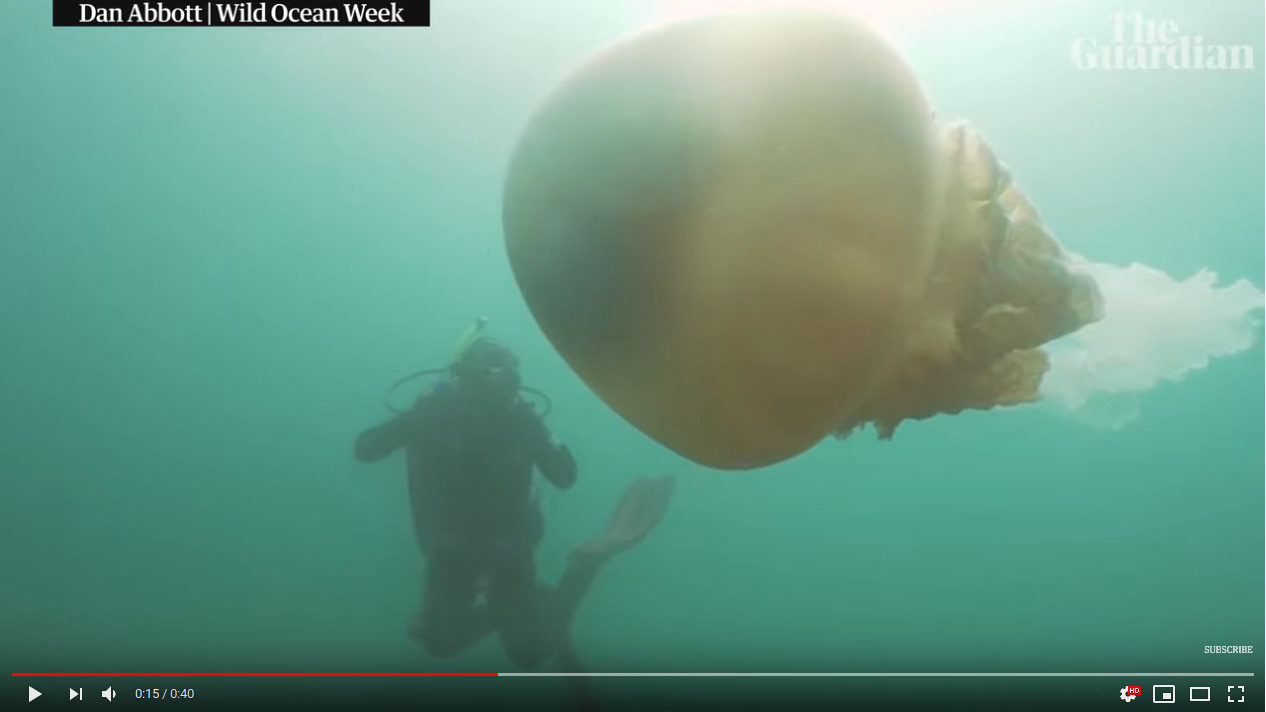"I've never seen one that big," said Lizzie Daly, a biologist who saw the creature near Falmouth. "We had seen a few smaller jellyfish at a beautiful reef nearby, and then out of the murk came this huge, beautiful jelly fish. You just take a double look and ask yourself if it's actually a metre and a half long."
She said swimming alongside the "gentle giant" was "such a serene, grounding experience".
Thousands of the creatures, the largest jellyfish found in British coastal waters, flock through the Atlantic Ocean towards warm coastal waters in the west of the UK each year and are often found washed up on beaches across May and June.
Owing to the late summer, the animals, which normally measure up to about a metre with their tentacles, were still being spotted in south-west England, south Wales and elsewhere. This was not unusual, Daly said, and the sightings were not part of a "freak jellyfish wash-up".
Comment: Actually, researchers have been tracking the changing habits of Jellyfish for years, and the extremely dry winter, spring, and the late summer, were also unusual: Europe's record breaking warm winter leads to unprecedented wildfires
Daly and an underwater camera operator, Dan Abbott, were diving in Falmouth as part of the online series Wild Ocean Week and stayed with the abnormally large, translucent bell-mushroom-shaped animal for about an hour before it swam away.
The pair said they were not surprised by the animal's behaviour. "It has got a very mild sting and poses no threat to humans - some people don't even feel it," Daly said. "Many people would be immediately worried, but it is not dangerous. Its a majestic creature."
However, she said her response may have differed if it was a Portuguese man o' war, which carries a potentially deadly sting.
Dr Michele Kiernan from the Marine Biological Association in Plymouth said little was known about the lifestyles of barrel jellyfish, including where their young live, and that their movements were at the mercy of winds and currents.
"As we've had a long spell of no rain in the south-west, people can see them more easily because of the clarity in the water," she said.
Their predators could also be reducing in number, she continued. Barrel jellyfish are the favourite prey of leatherback turtles, while they are also eaten by other animals which are increasingly "getting caught in entanglements and waste in the water."
In 2015, flocks of barrel jellyfish, which each have eight frilly tentacles, were seen gliding through the sea off the Cornwall coast. The animals, nicknamed dustbin lid jellyfish because of their shape and size, are attracted inshore by plankton blooms.




Comment: It makes sense that along with our cooling climate and the rise in extreme weather events, the behaviour of the creatures on our planet is changing too:
- Jelly fish stings close 3 beaches in Spain
- Russian Arctic town suffers polar bear invasion
- Britain sees worrying rise in Asian Hornets - 80 nests found
- Giant squid caught alive in Japan
Also check out SOTT radio's: Behind the Headlines: Earth changes in an electric universe: Is climate change really man-made?